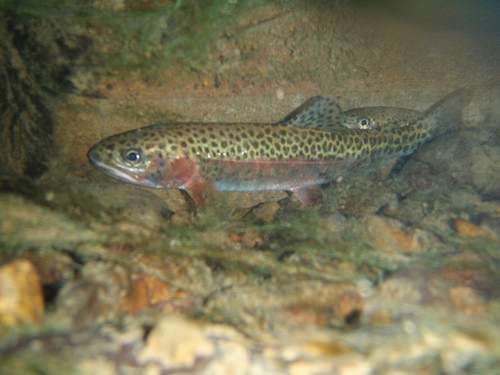Study finds shade, cover can reduce predation by birds on trout

As snowpack levels decline with the warming climate, many streams will experience less water flow, especially during summer months, potentially exposing more fish to predation by birds and other animals.
A new study has found that providing adequate shade and cover in small streams may reduce predation on trout by as much as 12 percent, from just one species of bird – the kingfisher. The findings, based on a study at the Oregon Hatchery Research Center in the Alsea River basin, are being published in the journal Ecology of Freshwater Fish.
Lead author Brooke Penaluna, who is a research fish biologist with the U.S. Forest Service's Pacific Northwest Research Station in Corvallis, said the findings may give fisheries managers a new tool to help mitigate the effects of climate change and better preserve fish populations during low-water regimes.
"We're able to tell fisheries managers that they may be able to increase their trout population by 12 percent – and it may be higher," said Penaluna, who led the research as a doctoral student in the Department of Fisheries and Wildlife at Oregon State University. "It is possible that adding shade and cover to small streams may help protect trout against other predators as well."
Avian predation of fish is hard to quantify in the wild because it is difficult to monitor and researchers don't know how many fish are in a particular section of a stream. So Penaluna and her colleagues set up a study at the Oregon Hatchery Research Center where they could control the number of fish in a section of stream, monitor predation, and control the amount of cover available.
Using coastal cutthroat trout, they found that individual fish sought cover at least as large as their own bodies, and the addition of in-stream cover reduced the rate of predation from kingfishers by 12 percent. Trout also had better survival in areas with greater shade.
"It is generally assumed that shade is good for fish solely because of temperature," said Jason Dunham, an aquatic ecologist with the U.S. Geological Survey and co-author on the study. "This study shows shade can make it more difficult for kingfishers to spot and catch fish. Kingfishers are the number one predators of small trout."
"Eighty percent of the streams in the U.S. are the same size or smaller than those studied at the hatchery," added Dunham, a courtesy faculty member in OSU's Department of Fisheries and Wildlife. "This study provides important information for streams that could be among the first affected by climate change."
Cover is particularly important during late summer months when water levels are naturally low and deep pools are hard to find, the researchers say. Adding wood or rocks to streams for cover may help protect cutthroat trout and other fish at a low cost.
"The beauty of this study is in its simplicity," said David Noakes, an OSU professor of fisheries and wildlife and director of the Oregon Hatchery Research Center. "We wanted to know the impact of shade and cover on fish, and Brooke was able to find that out. It is a very useful piece of knowledge."
More information: "Instream cover and shade mediate avian predation on trout in semi-natural streams." Ecology of Freshwater Fish. doi: 10.1111/eff.12221
Provided by Oregon State University

















